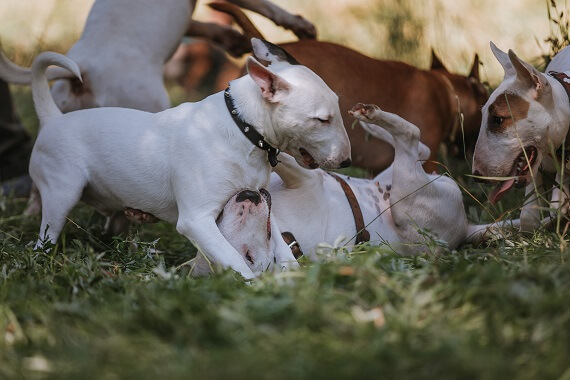
The Mini Bull Terrier or Miniature Bull Terrier is, as its name suggests, similar to the bull terrier but much smaller in size. It is a friendly and devoted companion that is inquisitive and playful. Some people have described this dog as a three-year-old clown due to its mischievous antics. Like all of the bully breeds, this dog is very muscular, especially for its size. Miniature Bull Terriers have a short-haired, glossy coat that is mainly white but can sometimes have patches of other colors, such as fawn, red and black. They have a long, oval-shaped head that has small, deep-set eyes that are triangular in shape which makes them very distinctive from other dogs. They also have strong jaws and natural upright ears. While many people think that this small dog will be easier to handle than the full-sized Bull Terrier, they are wrong. This dog has just as much energy as the bigger breed and is just as much of a handful. Mini bull terriers are inquisitive and are independent thinkers that have an urge to explore, dig, and bark. They can be difficult to train but can be obedient if they are interested and well-motivated. For this reason, they need firm and consistent training from a young age with established boundaries. That being said if these dogs are kept stimulated through exercise and games then they make wonderful pets and are capable of understanding that certain behaviors are best for outside. These dogs make great hiking companions and excel at agility and other canine activities. These dogs can get on well with other dogs, and cats and can make good playmates for children, although they will be too much of a handful for younger children. They also have a high prey drive so the yard will need to be well fenced to prevent them from getting out and chasing after a rabbit or a squirrel or whatever has caught their eye. Mini bull terriers are a rare sight, although interest in the breed is gradually growing. These dogs have been around for a while and were first recognized as a breed in the UK in 1939. However, it was not until 1991 that the American Kennel Club recognized this breed. The Mini Bull Terrier may be small in size but it makes up for that in personality. This happy-go-lucky dog makes a loving companion for any household that can cope with its endless energy. Let’s take a closer look at this mischievous dog. The miniature bull terrier came about in the early 1900s as the standard bull terrier gained popularity in the UK and the US. It was developed from the standard bull terrier through selective breeding. Although it is much smaller than the standard bull terrier, it is believed to be roughly the same size as the original bull terriers that were found in the UK during the 1800s. Bull terriers were originally bred to hunt vermin, such as mice and rats, and to engage in blood sports such as dogfighting. The first bull terriers were bred to have the strength and physical characteristics of a bulldog while having the intelligence and agility of the terriers. They wouldn’t have looked a lot like the bull terriers we see today, instead, they were described as having a menacing look about them with cropped ears and a rough appearance. As the dog breed evolved, the dogs became more like the bull terriers we see today. They were much lighter and had a more energetic temperament than their predecessors. The miniature bull terrier came about later as a much smaller, manageable breed than the standard bull terrier. Miniature terriers today still retain some of the fighting tendencies that they were bred for so owners need to know that these dogs will fire up against other animals if provoked. Miniature bull terriers are more likely to be prone to deafness than a lot of other dog breeds. Congenital Sensorineural Deafness is the most common type of deafness in dogs and is associated with white pigmentation genes. In dogs, the merle or piebald genes cause suppression of melanocytes which is thought to cause degeneration of the cochlear blood supply, causing deafness in the animals at 3 – 4 weeks of age. This can result in deafness in one or both ears. This type of deafness is hereditary and animals that display signs of deafness should be tested to confirm if they are deaf. This is important to prevent deaf dogs from being bred and putting their offspring at risk of having the same condition. This type of deafness has been found in over 100 dog breeds, with it being more prevalent in those carrying the piebald gene such as Dalmatians, Australian Cattle Dogs, English Setters, English Cocker Spaniel, and the Boston Terrier. Mini bull terries can sometimes display a compulsive behavior where they repeatedly engage in spinning or chasing their tail. This can become a problem when the dog repeats this behavior over and over again and it begins to interfere with its normal life. This canine compulsive disorder is considered to have a hereditary factor, although it can also be bought on as a result of its environment. For example, these behaviors are more likely to surface if the dog is not stimulated or exercised enough and it becomes bored. This disorder is anxiety-related, and may never manifest in those that are susceptible to it if its environment is ideal. In contrast, a dog that is exposed to environmental triggers but is not susceptible to this disorder won’t display the behavior. Spinning can be triggered by some environmental factors that can cause a dog stress. If this behavior begins then it is important to identify the cause of the dog’s stress so that it can be eliminated to help prevent the behavior occurring. It is also important to work on training that reduces the dog’s anxiety and redirects their behavior towards more appropriate behaviors using positive reinforcement training.
Kingdom
Animalia
Phylum
Chordata
Class
Mammalia
Order
Carnivora
Family
Canidae
Genus
Canis
Species
Canis lupus
Subspecies
Canis lupus familiaris
Height
10 – 14 inches (25.5 – 35.6 cm)
Weight
25 – 33lbs (11.3 – 15 kg)
Lifespan
11 – 14 years
Social Structure
Domesticated, Terrier
Status
Least concern
Natural Habitat
Domesticated
Average Litter Size
1 – 5 pups
Main food item
Dog food
Potential predators
Few predators
The Basics

Fun Facts about the Mini Bull Terrier!
Bull Terriers were Bred to Fight

Congenital Sensorineural Deafness

Obsessive Tail Chasers
